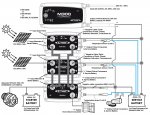Those battery bank capacity numbers are actually irrelevant. They are not "limits", they are "recommendations". Any charger can charge any size battery bank. The charger works the same no matter if hooked up to a 10ah battery or a 10Kah battery.
The question is if the charger has the amperage capacity to recharge the battery in a timely fashion.
What CTEK is saying with those numbers, is that their equipment is too small to get the job done in a reasonable time if the bank is too big.
Also, the engine bank size is completely irrelevant - it is "upstream" of the CTEK gear. From what I understand, the 250s will pulse/trickle a bit of solar current to the engine bank once the house bank is charged. I wouldn't count on it to do a good job of charging a large engine bank that is regularly drawn down.
And if the engine bank is only used to start the truck and service the chassis loads (as it should be), and not used to service house loads, then it will be fully charged all the time anyway (from the alternator), and providing a way to charge it, say from solar or shore power, is nice to have, but not actually necessary.
My recommendation would be to go with something like the Blue Sea 500a dual sensing ACR, to get the max bulk amps available from the alternator to the house battery to bulk up the house battery in the shortest time (absorb charging will still take many hours no matter what you use).
Hook the 500w of solar to the house battery with some top quality MPPT charge controller - Midnite, Morningstar, Victron etc.
Then buy the biggest shore charger you can provide power for and connect it to the house bank. For instance, a 90a Iota with IQ/4, a pair of 60a Xantrex TrueCharge 2s, a Xantrex Prosine 2.0 inverter/charger (100a charge current to a 12v bank).
(Of course if you are planning to use a small generator like a Honda eu2000i, you might only be able to power a 45a-55a charger.)
Getting the house bank bulked up quickly is the key issue to be considered. Hours of absorb charging is still hours of absorb charging no matter what you do. Keeping the chassis bank regulary topped off from solar or shore power is just a nice side benefit and the ACR will provide that - AFTER the house bank is bulked up.

